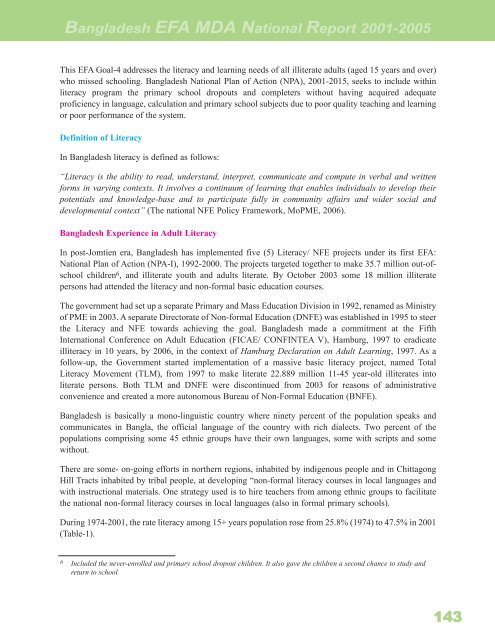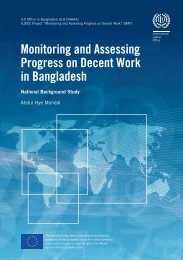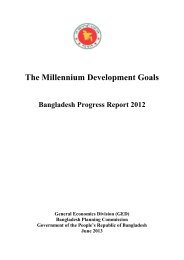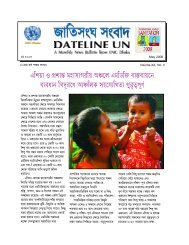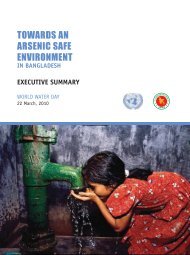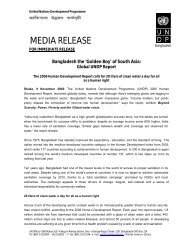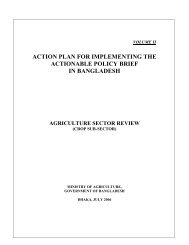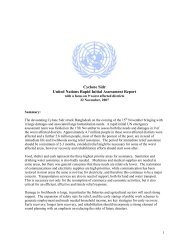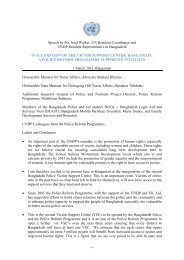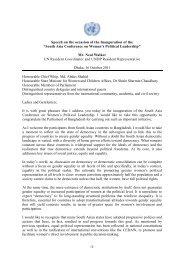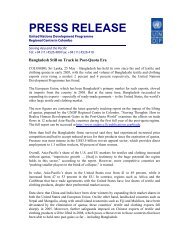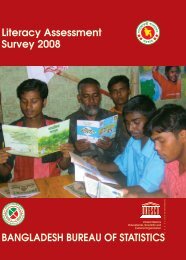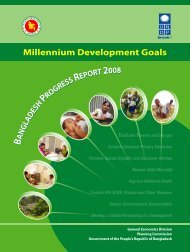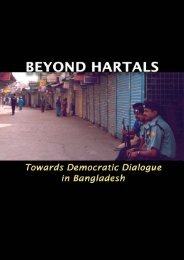Bangladesh EFA MDA National Report 2001-2005 - United Nations ...
Bangladesh EFA MDA National Report 2001-2005 - United Nations ...
Bangladesh EFA MDA National Report 2001-2005 - United Nations ...
Create successful ePaper yourself
Turn your PDF publications into a flip-book with our unique Google optimized e-Paper software.
<strong>Bangladesh</strong> <strong>EFA</strong> <strong>MDA</strong> <strong>National</strong> <strong>Report</strong> <strong>2001</strong>-<strong>2005</strong>This <strong>EFA</strong> Goal-4 addresses the literacy and learning needs of all illiterate adults (aged 15 years and over)who missed schooling. <strong>Bangladesh</strong> <strong>National</strong> Plan of Action (NPA), <strong>2001</strong>-2015, seeks to include withinliteracy program the primary school dropouts and completers without having acquired adequateproficiency in language, calculation and primary school subjects due to poor quality teaching and learningor poor performance of the system.Definition of LiteracyIn <strong>Bangladesh</strong> literacy is defined as follows:“Literacy is the ability to read, understand, interpret, communicate and compute in verbal and writtenforms in varying contexts. It involves a continuum of learning that enables individuals to develop theirpotentials and knowledge-base and to participate fully in community affairs and wider social anddevelopmental context” (The national NFE Policy Framework, MoPME, 2006).<strong>Bangladesh</strong> Experience in Adult LiteracyIn post-Jomtien era, <strong>Bangladesh</strong> has implemented five (5) Literacy/ NFE projects under its first <strong>EFA</strong>:<strong>National</strong> Plan of Action (NPA-I), 1992-2000. The projects targeted together to make 35.7 million out-ofschoolchildren 6 , and illiterate youth and adults literate. By October 2003 some 18 million illiteratepersons had attended the literacy and non-formal basic education courses.The government had set up a separate Primary and Mass Education Division in 1992, renamed as Ministryof PME in 2003. A separate Directorate of Non-formal Education (DNFE) was established in 1995 to steerthe Literacy and NFE towards achieving the goal. <strong>Bangladesh</strong> made a commitment at the FifthInternational Conference on Adult Education (FICAE/ CONFINTEA V), Hamburg, 1997 to eradicateilliteracy in 10 years, by 2006, in the context of Hamburg Declaration on Adult Learning, 1997. As afollow-up, the Government started implementation of a massive basic literacy project, named TotalLiteracy Movement (TLM), from 1997 to make literate 22.889 million 11-45 year-old illiterates intoliterate persons. Both TLM and DNFE were discontinued from 2003 for reasons of administrativeconvenience and created a more autonomous Bureau of Non-Formal Education (BNFE).<strong>Bangladesh</strong> is basically a mono-linguistic country where ninety percent of the population speaks andcommunicates in Bangla, the official language of the country with rich dialects. Two percent of thepopulations comprising some 45 ethnic groups have their own languages, some with scripts and somewithout.There are some- on-going efforts in northern regions, inhabited by indigenous people and in ChittagongHill Tracts inhabited by tribal people, at developing “non-formal literacy courses in local languages andwith instructional materials. One strategy used is to hire teachers from among ethnic groups to facilitatethe national non-formal literacy courses in local languages (also in formal primary schools).During 1974-<strong>2001</strong>, the rate literacy among 15+ years population rose from 25.8% (1974) to 47.5% in <strong>2001</strong>(Table-1).6 Included the never-enrolled and primary school dropout children. It also gave the children a second chance to study andreturn to school.143


